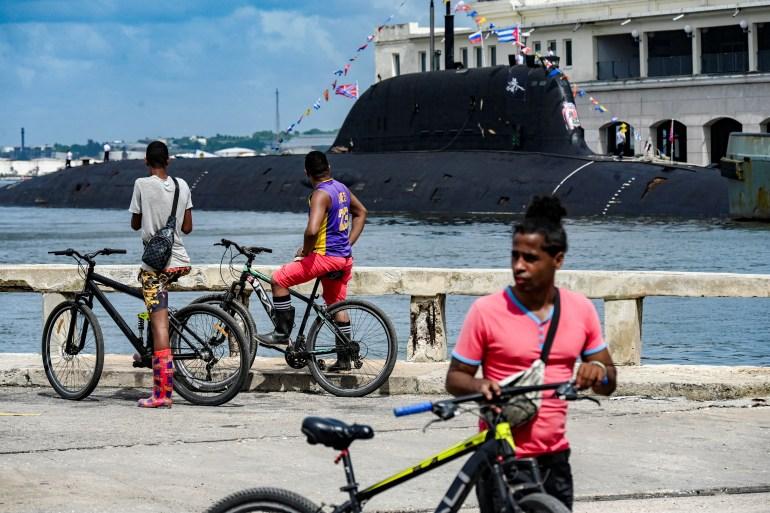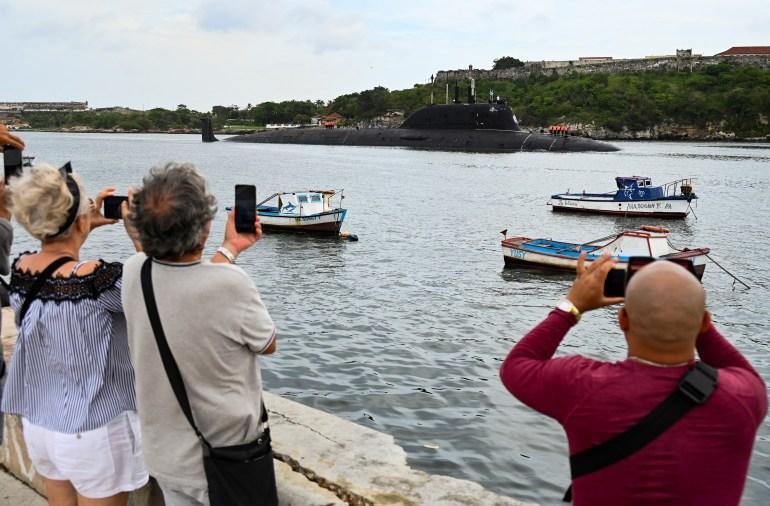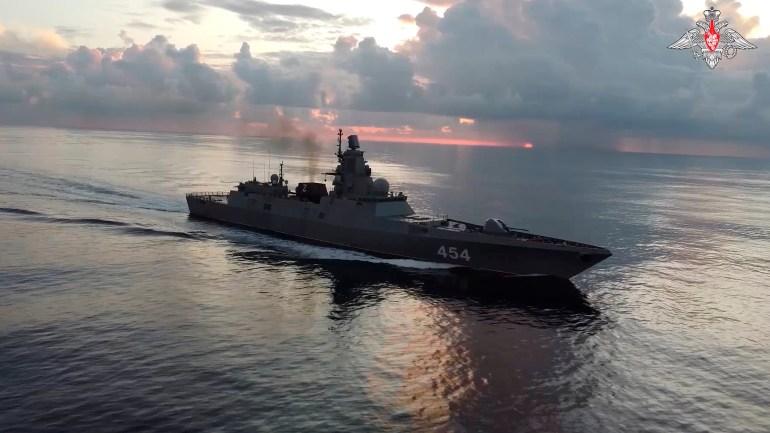Source: ALJAZEERA
ALJAZEERA MEDIA NETWORK

Russian naval vessels have sailed into Cuba’s main port, seemingly as a strategic display by Moscow amid increasing tensions with the United States.
On Wednesday, many residents of Havana gathered to witness Russian warships arriving in Cuba’s main port, marking a notable naval display by Moscow amidst rising tensions with the United States.
This Caribbean island nation, a neighbor of the US, has maintained fraught relations with it for decades, despite being just about 150 kilometers (94 miles) apart at their closest points.
This convoy, although not the first to visit Cuba, seems to be the largest Russian fleet to do so in years. The fleet is scheduled to remain until June 17, allowing the public to tour the vessels.
Here’s what we have gathered about the timing of this naval visit, the historical ties between Russia and Cuba, and their recent closeness:
 people take photos
people take photos
Cuban authorities describe the flotilla’s presence as a “friendly” routine visit between the naval forces of both nations, with the crew expected to undertake military exercises during their Caribbean stint.
However, analysts suggest this move by Moscow is a strategic show of naval strength in close proximity to the US. The deployment coincides with escalating US-Russia tensions, particularly following President Joe Biden's authorization in May allowing Ukraine to strike Russian targets with American weapons.
President Putin has warned of retaliation not just against the US but also against other Western allies of Ukraine, who have removed restrictions on their weapons being used against Russia.
Putin asserted, “That would signify their direct involvement in the war against Russia, and we retain the right to reciprocate similarly.” He also indicated Moscow’s preparedness to employ nuclear weapons.
According to Benjamin Gedan, director of the Latin America program at the Wilson Center, the warships remind Washington of the inconveniences of adversarial presence near their borders. The show of force also reassures Moscow’s allies, such as Cuba and Venezuela, of continued support against Washington, some experts note.

 Admiral Gorshkov
Admiral Gorshkov
The Russian fleet comprises a total of four vessels:

US officials publicly downplay the deployment, suggesting it is a standard port-visit practice between Russia and Cuba.
National Security Adviser Jake Sullivan stated on Wednesday that such naval activities are routine, emphasizing no indications that Moscow is transferring missiles to Havana.
Last July, a Russian training ship, Perekop, visited Havana for four days, participating in various activities, while the Admiral Gorshkov itself visited in 2019.
Sullivan noted, “We've observed similar actions before and anticipate more in the future. We won't attribute any specific motives, but we remain vigilant.”
US ships and aircraft monitored the fleet’s movement before its entry into Cuba, confirming no nuclear weapons on board, and noted the fleet stayed in international waters until arrival.

Russia’s Defence Ministry reported on Tuesday that the fleet had undertaken exercises in the Atlantic en route to Cuba, practising high-precision missile use against simulated enemy ship targets over 600km away.
Meanwhile, the Cuban Foreign Ministry, before the fleet’s arrival, asserted that no nuclear weapons were on board and emphasized that the presence does not pose a threat to the region.
“Naval visits from other nations are a longstanding practice of the revolutionary government with countries sharing friendly and collaborative relations,” stated the ministry.
Russia and Cuba have historically opposed the US, building strong ties during the Cold War when the Soviet Union supported Havana with financial aid, military gear, and training, bolstering Cuba’s military capabilities.
This partnership peaked in 1962 when the Soviet Union’s deployment of nuclear missiles to Cuba led to the Cuban Missile Crisis. This period of heightened tension saw the US enforce a naval blockade around Cuba.
The dissolution of the Soviet Union left Cuba without a key economic patron, leading to a deep economic crisis. However, in recent years, their cooperation has revived.
Experts indicate that the current naval display signifies a renewed partnership, though not necessarily a repeat of 1962 events. Cuba’s renewed interest in Russia is more for economic reasons rather than ideological alignment.

The US has enforced one of the longest-standing trade sanctions against Cuba since 1958, following Fidel Castro's overthrow of a US-backed government. Although these sanctions have ebbed and flowed over time, they largely remain intact.
In 2015, President Barack Obama reestablished diplomatic relations with Cuba after 50 years, but President Donald Trump reversed this decision nearly four years later, contributing to Cuba's enduring economic struggles.
Cuban Foreign Minister Bruno Rodriguez Parrilla described US sanctions as a “crime of genocide” during a UN General Assembly meeting last November.
Regular power outages, food and fuel shortages, high inflation, and declining public services have pushed Cuba into its worst economic crisis in decades.
In turn, Cuba has looked to Russia for economic support, with the two countries establishing a series of economic partnerships. Russian firms are now allowed to lease Cuban land for 30 years, marking an uncommon move in the traditionally restrictive nation.
Trade between Cuba and Russia reached $450 million in 2022, triple that of 2021, largely driven by Russian petroleum product and soy oil sales, providing much-needed fuel to Cuba.
Ricardo Cabrisas, Cuba's former minister of foreign commerce, expressed optimism at a business forum last May, asserting that Cuban-Russian economic ties would only grow stronger.
“Nothing and no one can stop it,” Cabrisas declared.
Your email address will not be published. Required fields are marked *